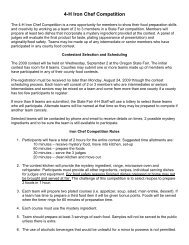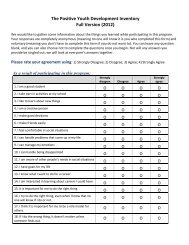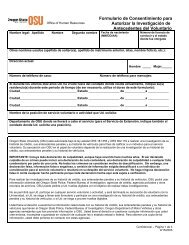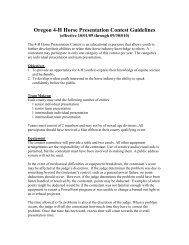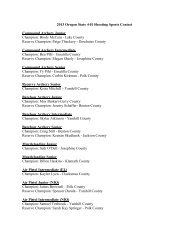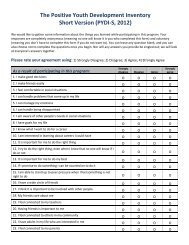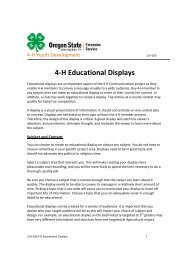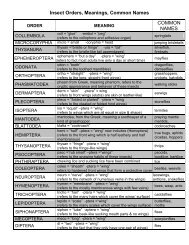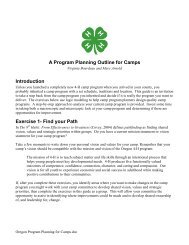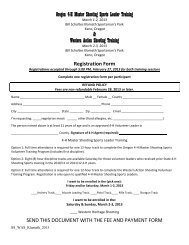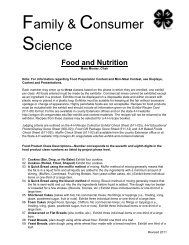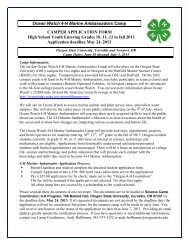Oregon 4-H Foods and Nutrition Leader Guide - Oregon State 4-H ...
Oregon 4-H Foods and Nutrition Leader Guide - Oregon State 4-H ...
Oregon 4-H Foods and Nutrition Leader Guide - Oregon State 4-H ...
- No tags were found...
You also want an ePaper? Increase the reach of your titles
YUMPU automatically turns print PDFs into web optimized ePapers that Google loves.
2012<strong>Oregon</strong> 4-H <strong>Foods</strong> <strong>and</strong> <strong>Nutrition</strong><strong>Leader</strong> <strong>Guide</strong>PILOT Edition511-16L
AcknowledgementsWritten by Pamela Rose, Ph.D., <strong>Oregon</strong> <strong>State</strong> University Extension Service 4-H Youth DevelopmentSpecialist, with the assistance of the <strong>Oregon</strong> 4-H Food/<strong>Nutrition</strong> Curriculum Committee: KarlinaChristensen, Patricia Dawson, Anne Manlove, <strong>and</strong> Janice Smiley. College of Public Health <strong>and</strong> HumanSciences. <strong>Oregon</strong> <strong>State</strong> University.Photographs: Lynn Ketchum <strong>and</strong> Pamela Rose<strong>Oregon</strong> <strong>State</strong> University Extension Service offers educational programs, activities, <strong>and</strong> materialswithout discrimination based on age, color, disability, gender identity or expression, marital status,national origin, race, religion, sex, sexual orientation, or veteran’s status. <strong>Oregon</strong> <strong>State</strong> UniversityExtension Service is an Equal Opportunity Employer.1
Table of ContentsIntroduction…………………………………………………………………….…………… 34-H Philosophy…………………………………………………………………….……….. 3Curricula to Use: Member Materials…………………………………………………… 4<strong>Leader</strong> Materials <strong>and</strong> Support Materials………………………………………………. 6How to use Curricula – Putting into Practice..………………………………………. 7Getting Organized for your Club Meetings……………………………………………. 8Alternative Diets……………………………………………………………………………. 10Recording Growth…………………………………………………………………………. 10Preparing Youth for Competition in Exhibits <strong>and</strong> Contests……………………….. 11References …………………………………………………………………………………. 164-H Club Meeting Planning Form <strong>and</strong> Sample……………………………………….. 172
<strong>Oregon</strong> 4-H <strong>Foods</strong> <strong>and</strong> <strong>Nutrition</strong> <strong>Leader</strong>s <strong>Guide</strong>Welcome <strong>and</strong> Thank YOU!Welcome to the amazing experience of volunteer leadership! You have taken on one ofthe most challenging yet rewarding roles – that of guiding <strong>and</strong> mentoring youth in theirjourney of discovering the joy of cooking <strong>and</strong> the power of self-confidence.Youth are eager to make something they can eat. Youth are also eager to please. As a mentor <strong>and</strong> guide,you will model the methods utilized in the kitchen for proper food safety, food preparation, <strong>and</strong> foodetiquette. Pay attention to your own habits <strong>and</strong> demonstrate the techniques offered in the curriculum. Youwill also model <strong>and</strong> create the environment for safe trial <strong>and</strong> error, creative exploration, <strong>and</strong> the importanceof compliments <strong>and</strong> encouraging words. Provide positive feedback to all of your members <strong>and</strong> help themfeel pride in their accomplishments.4-H PhilosophyIn our focus on <strong>Foods</strong> <strong>and</strong> <strong>Nutrition</strong>, our goals are for young people to gain skills, knowledge <strong>and</strong>competency in food preparation, food safety, food selection, <strong>and</strong> food science.An important 4-H goal is to teach life skills. For example, in club or group settings, youth learn to takeresponsibility for their actions, to cooperate with others, <strong>and</strong> to communicate ideas or thoughts in front of agroup. The foods <strong>and</strong> nutrition project is designed to provide opportunities for youth to: develop decisionmaking,manage resources, become better consumers, express creativity, acquire knowledge, build socialskills, <strong>and</strong> gain sense of accomplishment.4-H teaches these skills to members through using a child-centered approach where means members areallowed to participate in their own learning. Youth set their own goals, measure their progress, <strong>and</strong>evaluate their results. As a mentor, using a child-centered approach involves giving members choices inactivities <strong>and</strong> experiences. You may want to limit the number of options your provide for members,however, youth are more likely to be motivated to do a task if it is one they have chosen for themselves.Setting the stage for Positive OutcomesWill your work with youth mean they will have a positive experience <strong>and</strong> be impacted in a meaningful way?Based on research, it is far more likely that youth will have a positive experience if we are very intentional inhow we design our activities. Please refer to the Positive Youth Development segment in the 4-H CookingHelper’s <strong>Guide</strong> for guidance on this area.3
Curricula to UseAs a volunteer we appreciate <strong>and</strong> acknowledge your commitment to our youth. The selected curricula werechosen to best meet the needs of volunteers. The curricula being utilized to support the <strong>Oregon</strong> 4-H <strong>Foods</strong><strong>and</strong> <strong>Nutrition</strong> project area is a combination of the 4-H Cooking Series, developed by University of IllinoisExtension Service <strong>and</strong> the 4-H Baking Series, developed by North Dakota <strong>State</strong> University ExtensionService. The two publication series complement each other <strong>and</strong> should be used in t<strong>and</strong>em: Cooking 101 <strong>and</strong> Baking 1 for first year beginning level members Cooking 201 <strong>and</strong> Baking 2 for second <strong>and</strong> third year beginning level members Cooking 301 <strong>and</strong> Baking 3 for exp<strong>and</strong>ing level members Cooking 401 <strong>and</strong> Baking 4 for advanced level membersThere are enough learning activities <strong>and</strong> recipes offered at each level (Cooking 201 <strong>and</strong> Baking 2 wouldbe considered a level) to spend one, two, or three years before moving on to the next level. What follows isa brief description of each of the curricula materials.Member MaterialsCookingThe 4-H Cooking Series includes four levels of project manuals. The manuals provide content information,food science experiments, <strong>and</strong> a variety of classic recipes that are youth-tested <strong>and</strong> youth friendly.Cooking 101 is designed for first year <strong>and</strong> beginning level members. Members will learnkitchen <strong>and</strong> food safety, basic food preparation <strong>and</strong> nutrition, <strong>and</strong> basic food science. Thecurriculum includes experiments, such as testing to determine which dishes aremicrowave-safe, as well as recipes, equipment information <strong>and</strong> a glossary. (IllinoisPublication ME0120-R12) – Price: $2.00Cooking 201 is designed for beginning level members, building on the skills acquired inCooking 101. The curriculum provides information about the science behind foodpreparation, the nutritional contribution of each food group <strong>and</strong> some basic informationabout preparing foods from each of the food groups. Topics include food safety, fire safetyin the kitchen, nutrition labels, experiments with rice <strong>and</strong> bacon, meal planning <strong>and</strong>recipes. (Illinois Publication ME0121) – Price: $2.75Cooking 301 is designed for intermediate level members, building on the skills acquired inCooking 101 <strong>and</strong> Cooking 201. The curriculum provides in-depth exploration of outdoorcooking on a charcoal or gas grill, party planning, cooking with slow cookers, <strong>and</strong> makingyeast breads <strong>and</strong> shortened cakes. There is background information to help explain thescience behind food preparation, including experiments about flour, yeast, butter <strong>and</strong>cheese. (Illinois Publication ME0122) – Price: $2.75Cooking 401 is designed for advanced level members, building on the skills acquired inthe previous three levels. The curriculum provides an in- depth exploration of preparingethnic foods; cooking with herbs <strong>and</strong> spices; planning celebration meals; preparing meatsby roasting, braising, <strong>and</strong> stewing; cooking dry beans; <strong>and</strong> making pastry, foam cakes,<strong>and</strong> desserts made with milk. (Illinois Publication ME0123) – Price: $2.754
BakingDesigned for the 4-H baking member wishing to develop skills necessary to produce a wide variety ofbaked products, developing skills in measuring, mixing, <strong>and</strong> learning the importance of bread in the diet,about ingredients <strong>and</strong> how they affect the finished project, <strong>and</strong> how to make various pastries.Underst<strong>and</strong>ing criteria for what makes a quality baked product is explored as well as tips for improvingskills in making baked goods.Baking 1 is designed to help first-year baking members learn baking basics – nutrition,measuring, baking terms, <strong>and</strong> kitchen safety. Curriculum is organized to cover one topic orfood at each club meeting. Youth will learn the basics of baking by making quick breads<strong>and</strong> cookies. They will also learn to judge the quality of each food product. (North DakotaPublication EC111) – Price: On-line downloadBaking 2 is designed to build upon basic concepts learned in Baking 1. Youth will learnhow to make more advanced types of quick breads <strong>and</strong> cookies, but also review basicmeasuring techniques <strong>and</strong> baking terms, <strong>and</strong> demonstrate the proper way to use bakingequipment <strong>and</strong> utensils when making the recipes in curriculum. They will continue to learnst<strong>and</strong>ards of quality for the products they are making. (North Dakota Publication EC112) –Price: On-line downloadBaking 3 is an introduction to yeast breads. It is very different from Baking 1 <strong>and</strong> Baking2, teaching different techniques. Curriculum is organized so one subject can be covered ateach meeting. Youth will learn about how ingredients affect the finished product, how toidentify the characteristics of high quality breads, <strong>and</strong> related bread making scienceexperiments. (North Dakota Publication EC113) – Price: On-line downloadBaking 4 is focused on the science of making good cakes <strong>and</strong> making good pastry.Underst<strong>and</strong>ing the way in which ingredients, temperature, mixing, <strong>and</strong> baking all influencethe outcome of these baked products is covered in this curriculum. (North DakotaPublication EC114) – Price: On-line download4-H Advancement <strong>Guide</strong> – is a series of activities to support the learning experiences withactivities offered across five learning areas: individual development, food preparation <strong>and</strong>food safety, science <strong>and</strong> management, nutrition <strong>and</strong> health, <strong>and</strong> consumerism. The guidecan assess skills <strong>and</strong> knowledge gained by members for both recognition <strong>and</strong> to determineif they are ready to move to a new level. (<strong>Oregon</strong> Publication) – Price: On-line download4-H Food <strong>and</strong> <strong>Nutrition</strong> Records – forms used to record learning, skills, activities, <strong>and</strong>growth in project. There are two record forms, one for Junior Members (4-6 th grade) <strong>and</strong>one for Intermediate <strong>and</strong> Senior Members <strong>Oregon</strong> Publication) – Price: On-linedownload5
<strong>Leader</strong> MaterialsThe following pieces have been created or are being utilized to support leaders in leading foods clubs.<strong>Oregon</strong> 4-H <strong>Foods</strong> <strong>and</strong> <strong>Nutrition</strong> <strong>Leader</strong>s <strong>Guide</strong> – is to assist adult <strong>and</strong> older youthvolunteers in leading 4-H clubs or groups. The guide reviews all of the curricula <strong>and</strong>presents ideas for incorporating both the Cooking <strong>and</strong> the Baking series into 4-H meetingstructures. Guidance is given on how to conduct <strong>and</strong> get organized for successful groupmeetings. Detailed information is also provided on preparing for county fair foods exhibits<strong>and</strong> foods contests. (<strong>Oregon</strong> Publication) – Price: On-line download<strong>Oregon</strong> 4-H <strong>Leader</strong> Supplement <strong>Guide</strong> <strong>Nutrition</strong> <strong>and</strong> Health Focus: IncorporatingDietary <strong>and</strong> Physical Activity <strong>Guide</strong>lines – is designed to assist adult <strong>and</strong> older youthvolunteers in underst<strong>and</strong>ing <strong>and</strong> incorporating dietary <strong>and</strong> physical activity guidelines within4-H clubs or groups. MyPlate is the showcase for helping to bring the dietary guidelines intopractice. Sample activities for having fun with learning MyPlate <strong>and</strong> getting members morephysical activity are included. (<strong>Oregon</strong> Publication) – Price: On-line downloadHelper’s <strong>Guide</strong> is designed to assist volunteers in utilizing the cooking series in working withyouth people <strong>and</strong> getting started with a 4-H club or group. The guide covers importantfundamental topics on working with youth such as: positive youth development,underst<strong>and</strong>ing <strong>and</strong> working with youth, <strong>and</strong> experiential learning. A section on best practicesfor a 4-H cooking club, a list of learning objectives for each of the cooking levels, <strong>and</strong>suggested learning activities provides the leaders with some direction <strong>and</strong> guide for how touse the cooking series. (Illinois Publication ME0124) – Price: $2.00Support MaterialsA number of other pieces <strong>and</strong> suggested websites have been created or chosen to round out the curricula<strong>and</strong> provide leader support for the 4-H <strong>Foods</strong> <strong>and</strong> <strong>Nutrition</strong> Project including:<strong>Oregon</strong> 4-H Science Rich H<strong>and</strong>book Series: Focus on <strong>Foods</strong> Project – is to assistadult <strong>and</strong> older youth volunteers in integrating science inquiry within 4-H clubs or groups.The h<strong>and</strong>book gives information on what is science, how to build it into our projects, <strong>and</strong>gives activities to use with members. (<strong>Oregon</strong> Publication) – Price: On-line downloadAltering Recipes for Good Health is designed to provide assistance in modifying <strong>and</strong>revising recipes to meet desired health needs or outcomes. Information on detecting fat,sugar, fiber <strong>and</strong> salt in recipes is given as well as tips on removing or substituting theseitems in recipes. There are also helpful resources. (Texas Publication) – Price: On-linedownloadThe Healthy Recipe Cookbook – Tasty recipes <strong>and</strong> tips for fun <strong>and</strong> affordable familymealtimes (<strong>Oregon</strong> Publication – Food Hero, 2010) – Price: $1.00Un Libro de Cocina De Recetas Saludables – Recetas y consejos para la familia decomo hacer comidas deliciosas, diveritidas y con un bajo costo (<strong>Oregon</strong> Publication – FoodHero, 2010) – Price: $1.006
Website MaterialsFood Hero Website– this website provides a great array of healthy recipes, tips for eating <strong>and</strong>preparing healthy food, <strong>and</strong> additional meal planning information. Created by the OSU ExtensionService. Available at: www.foodhero.orgMyPlate Website – this website provide numerous resources to help teach young people aboutselecting <strong>and</strong> eating a healthy diet. Available at: www.choosemyplate.govEat Smart, Play Hard – this website promotes the USDA’s Food <strong>and</strong> <strong>Nutrition</strong> Service (FNS), EatSmart, Play Hard campaign teaching young people about selecting a healthy diet <strong>and</strong> beingphysically active. Available at: www.teamnutrition.usda.gov/Resources/eatsmartmaterials.htmlPhysical Activity for Life – this website promotes physical activity. A specific resource on thiswebsite is a Balanced Energy – Physical Activity Toolkit. This toolkit was designed to integratephysical activity <strong>and</strong> nutritional concepts. Available at:http://extension.oregonstate.edu/physicalactivity/BEPAHow to use the Curricula - Putting it into PracticeSo how do you use all of the great curriculum, support materials, <strong>and</strong> website resources? Here are somesuggestions for putting the curricula into practice with your club or group.Suggestion 1. Follow the “Beginner 4-H Cooking Project Suggested Learning Activities” as described in 4-H Cooking Helper’s <strong>Guide</strong>. This sample layout is for a six-week beginner project club or group, ending witha culminating event as the seventh session. This sample layout can be used the second year with yourgroup as well by changing out recipes <strong>and</strong> adding other activities. The four segments in 4-H Baking 1series on making biscuits, muffins, pancakes <strong>and</strong> cookies can be incorporated into the sessions covered inthe six-week layout or can be additional st<strong>and</strong>-alone sessions where additional emphasis is placed onunderst<strong>and</strong>ing the st<strong>and</strong>ards of quality for the baked product <strong>and</strong> evaluating the baked item on its merits.Suggestion 2. Use the “4-H Club Meeting Planning Form” to plan your next meeting.Most 4-H foods club meetings probably meet for about 90 minutes. Determine some of the skills you wantmembers to gain <strong>and</strong> foods you want to practice preparing. Then let the materials help you fill in therecipes, activities, <strong>and</strong> concepts to teach or facilitate. A sample template, focusing on Fruits, is included inthe Appendix as is a blank form. Categories on the template include:Meeting focusRoll call<strong>Nutrition</strong> messageRecipeFood supplies <strong>and</strong> equipmentFood equipment SkillsFood preparation skillsScience ideaPhysical activity ideaConsumerism ideaIndividual development ideaProduct evaluationTake Home Message7
Getting Organized for your Club MeetingsYou will find that investing some time in planning <strong>and</strong>preparing before each club meeting will save valuabletime <strong>and</strong> help increase your confidence in facilitating yoursession. Here is a general checklist to help you prepare. Determine the focus of your meeting <strong>and</strong> whatyou want members to learn.Become familiar with the recipes you are going tomake <strong>and</strong> the content or skills you want to teach.Estimate the time it might take your group to conclude all tasks. Try to include the following aspectsof successful club meetings at each of your meetings:o Build in time for members to get reacquainted with each othero Review goals, expected conduct, <strong>and</strong> safety aspectso Build in other aspects of the foods & nutrition project beside food preparation, such asconsumerism, management, science, nutrition, healthy living, food safetyo Share important news <strong>and</strong> updates regarding the county programo Engage members in discussions, activities, <strong>and</strong> club decision-making Gather or shop for materials. Managing the costs of food.There are different ways to manage the financial aspects of managing a foods club. Choose whatworks for your club but keep good financial records <strong>and</strong> submit necessary financial paperwork intothe county extension office.o Charge a cooking lab fee to members for club related food costso Raise money as a club for your cooking lab costso Have each club member contribute needed food itemso Donate spices or other food items from your pantry to the clubo Have clubs members make decisions about lower cost substitutionso Pursue samples from companieso Ask parents or members to contribute through couponing or donating in-kind products Create a comfortable <strong>and</strong> safe environment.Set up your meeting area to maximize interaction <strong>and</strong> enjoyment of your meeting. Be creative.Make your time together fun…<strong>and</strong> relevant.o Acknowledge all ideas <strong>and</strong> input, even if not used in the end.o Call on members by name. Get to know things about your members.o At every chance, ask for volunteers or get participants involved in the meeting.o Acknowledge positive behaviors frequentlyo Encourage group members to share experienceso Demonstrate respect for participants <strong>and</strong> their beliefso Incorporate current events into your discussiono If youth appear restless or bored, take a minute or two to do a physical activityo Ask open ended questions, instead of close-ended questionso Be enthusiastic <strong>and</strong> model the behaviors you are seekingo Have members dish up for themselves so they are determining the amount to tryo Encourage members to explore foods <strong>and</strong> try new things, but don’t force them to eatsomething. Set the tone for having an adventure with food!8
Preparing to cook with members.Cooking takes close supervision <strong>and</strong> support. The size of your club may be determined by the sizeof your facilities. Consider the height of your members being able to complete the tasks. Whencooking with your members, consider these tips:o Disinfect kitchen with kids before you starto Get out supplies in advance (except perishable items)o Only set out the tools <strong>and</strong> equipment necessary for the taskso Use baking trays – equipment on some, food on one, dirty dishes for third trayo Have copies of recipe that will be preparedo Divide cooking/baking by steps so each member shares in the food preparation.o Clean as you go Engage your members.Always remember that what the youth learns from the experience is more important than thequality of the finished food product or activity. Members will gain more from the experience <strong>and</strong>remember more from what they are learning when they are engaged in the process. For example,when involved in food preparation, members can be engaged through rotating tasks amongmembers, for example:o Disinfecting kitcheno Reviewing kitchen & food items before you begino Washing <strong>and</strong> rinsingo Drying <strong>and</strong> putting awayo Setting the tableo Serving the foodo Leading the table conversationso Leading the record keeping sectiono Transferring recipe to place in recipe collection Make the most of the diversity of your members.Recognize <strong>and</strong> celebrate the richness <strong>and</strong> diversity of the cultures, backgrounds, traditions, <strong>and</strong>ethnicities represented in your group. Adapt the discussions <strong>and</strong> activities to reflect the identities ofyour group. At the same time, be alert to instances where highlighting cultural <strong>and</strong> ethnic identitymay be uncomfortable for the youth. If your group involves members with disabilities, look for waysto provide meaningful engagement in club activities.o Discuss with the parent(s)/guardian(s) what actions are required to ensure successfulintegration into club activitieso Clarify support that will be provided by parent/guardian/primary care giver.o Consider options for adjusting time needed, rest periods, space needed, etc.o Modify number of steps to complete activity, or other adjustments as needed based ontheir type of impairment or disability. Prepare for the unexpected.Even the best of plans need to be flexible. A club environment is a time for experimentation <strong>and</strong>discovery. Do not be rigid in expectations. Adjust to meet the needs of the individuals in group. Behard in st<strong>and</strong>ards of food safety, but soft in expectations of end results. Thoughts:o Have back up activities to do if tasks are accomplished faster than you think9
o Think of things that you can do as a group while you may be waiting for a timer, such asfilling out a portion of 4-H records, setting the table, doing some jumping jacks, researchingwhere one of the food products came from.o Plan for ways to h<strong>and</strong>le information if a parent comes early to get their child.Alternative Diets <strong>and</strong> AllergiesIn your 4-H club or group, it is important to assess your members’ dietary needs so that your cooking <strong>and</strong>food preparation activities can be sensitive to these special needs. Utilize information provided on the 4-Hhealth form <strong>and</strong>/or conduct a family interview to make sure all food allergies <strong>and</strong> special dietary needs areknown <strong>and</strong> recorded. A resource for helping with these needs that can be downloaded on the OSUExtension website is “Altering Recipes for Good Health”.Recording Growth4-H Records4-H Records help members track learning, growth, costs, <strong>and</strong> accomplishment of goals. Record keepingalso provides members the opportunity to gain skills in expressing their thoughts, following directions,summarizing ideas, <strong>and</strong> financial recordkeeping. 4-H <strong>Foods</strong> records allow members to track meals or fooditems prepared <strong>and</strong> evaluate the results of the products. There is also a place to record foods related skills,such as consumerism, nutrition <strong>and</strong> health, science <strong>and</strong> management, <strong>and</strong> also food equipment <strong>and</strong> safety.4-H Records are a sure way to prepare members for the workforce as well as a way to evaluate the pastyear. Depending on the situation, records may also provide a way to receive special recognition.4-H Advancement <strong>Guide</strong>The purpose of 4-H Advancements is two-fold: 1) to assess member skills <strong>and</strong> knowledge before movingon to the next level <strong>and</strong> 2) to recognize members’ competencies in these areas. In order to get credit forcompleting an advancement option, members must demonstrate their knowledge or ability to do the listedtask. The objectives for each of the 4-H Cooking <strong>and</strong> 4-H Baking books have been integrated into the 4-HAdvancements.The advancement guide asks members to review a list of skills <strong>and</strong> then the members check those theyplan to do that year. The leader can assist the member in this planning. The leader <strong>and</strong> member will worktogether to determine when <strong>and</strong> how the member completes the task. When the task is completed, thedate is entered on the advancement guide <strong>and</strong> signed off by the leader or parent.Example:Plan Date Approved<strong>Nutrition</strong>/Health to do complete byChange a cookie recipe so it is more nutritious. ________ ________ ________Make <strong>and</strong> bake a nutritious version.10
Preparing youth for competition in <strong>Foods</strong> Exhibits or <strong>Foods</strong> Contests<strong>Foods</strong> ExhibitsYouth can prepare a baked item <strong>and</strong> enter it in 4-H competitions, aslong as the member <strong>and</strong> the exhibit meet local county 4-H programrequirements. Check with your County 4-H program for these dates,deadlines, <strong>and</strong> requirements. The Baking Series Curriculum providessections describing the st<strong>and</strong>ards of quality for each particular bakeditem. A judging st<strong>and</strong>ard score sheet is also provided. Utilize thesesources <strong>and</strong> the fair book descriptions when preparing items for exhibit competition.Materials for exhibit preparation can be found at: http://oregon.4h.oregonstate.edu/fair-exhibit-<strong>and</strong>-contestmaterials#hecUse these helpful cookie descriptions when assisting members in determining their cookie class:Bar cookies – cookies that are spread in a pan, baked <strong>and</strong> cutDrop cookies – soft dough that is dropped from a spoon or scoopNo Bake cookies – cookies that do not require bakingRolled cookies – somewhat stiff dough that is first rolled, then cut into various shapesFilled cookies – cookies that have a filling, such as fruit or nut, insideH<strong>and</strong> shaped cookies – is the art of forming dough into different shapesexamples: snickerdoodles, peanut butter, refrigerator, biscotti, s<strong>and</strong>iesSpecialty cookies – cookies are shaped with molds, presses or other special devicesexamples: spritz, piped, springerle, spekulatiusThe leader can support the members’ preparation for Fair involvement by:o Reviewing county 4-H program <strong>and</strong> exhibit requirementso Sharing tested recipes <strong>and</strong> helping members select recipes that meet criteriao Encouraging members’ participation <strong>and</strong> parental supporto Building in time at meetings for members to practice needed skillso Walking through steps of what will happen at fairo Practicing interview judging with memberso Hosting a cookie exchange or parent tea for members to share items made<strong>Foods</strong> ContestsYouth can prepare a food item(s) in front of a judge as a form of 4-Hcompetition, as long as the member meets local county 4-H programrequirements. Check with your County 4-H program for these dates,deadlines, <strong>and</strong> requirements. The following pages describe tips,techniques, <strong>and</strong> process in preparing for the foods contests. In addition tothe fairbook descriptions, these additional remarks will help you prepareyour members for a great experience.11
Food Preparation Contest Tips: Recipe Selection Ideas1. Decide whether the member wants to compete in the <strong>Foods</strong> of the Pacific Northwest Food Preparationcontest (one-hour) or the Mini Meal contest (two-hour), Individual or Team. They may choose to entermore than one contest.2. Youth will be timed <strong>and</strong> must adhere to the time limit for the contest they have entered. The clock startswhen the member enters the kitchen <strong>and</strong> ends when they leave the kitchen with dishes washed,counters <strong>and</strong> sink clean, boxes removed, ready to serve. Look for a recipe where the maximum bakingtime for a one-hour contest is 35-40 minutes (that only leaves 20-25 minutes preparation time).Consider cooling time if needed. Yeast breads are an exception as proofing time is not included for theone-hour contest.3. Look over a variety of recipe books to see what inspires. Follow the rules. The mini-meals contest onlyallows youth to prepare two dishes.4. Choose a recipe you <strong>and</strong> your family enjoys. You will eat it a lot during practices at home!5. Consider the skills involved <strong>and</strong> choose a recipe that demonstrates the skills you have mastered or newskills you plan to add this year. Making a peanut butter <strong>and</strong> jelly s<strong>and</strong>wich may be too simple but do notchoose a recipe far above your skill level for your first contest.6. Reduce the recipe if necessary to reduce the preparation <strong>and</strong> baking time to keep you within the timelimit. Remember that you only need to serve the judge. Halving the recipe <strong>and</strong> choosing smaller pansmay reduce your cooking time enough to enable you to make that dish you love. However, considerwhether you have the skills to get the batter into small pans neatly. Baking <strong>and</strong> serving from the samepan may be easier for small inexperienced h<strong>and</strong>s.7. Consider nutrition. Consider color. Bright orange carrot dill soup, scones dotted with red cranberries.8. Think about the specialty awards for cooking with dairy, lamb, beef, or fish.9. Consider using produce grown in <strong>Oregon</strong>. Pears from the Rogue Valley, or cranberries or hazelnuts.10. Think about a theme. Perhaps; An Evening in Paris, Cowboy Christmas Breakfast, a Mother’s DayBrunch. Consider coordinating your recipe, apron, poster <strong>and</strong> table setting to match your theme. If youenjoy sewing, sew your own apron or placemat <strong>and</strong> napkin <strong>and</strong> enter them as a clothing exhibit.11. The use of alcohol is not permitted in 4-H Contests. Think about substitutes if necessary!12. As a rule, you are not allowed to use mixes or pre-measured or pre-chopped foods. The judge wants toevaluate your skills. As our groceries offer more <strong>and</strong> more pre-chopped foods you might get away withbending this rule if you have shown chopping skills in other areas but different judges may feeldifferently about this subject.13. Think about your “presentation”. Could you bake a quick bread in a bundt or fluted pan instead of aregular loaf pan? Do you have time to add a garnish to make your plate look prettier?12
Food Preparation Contest Tips: PaperworkJudges Information FormA member must complete a judge’s information form for each contest they are participating in. The formcan be typed in or it can be h<strong>and</strong>written. The completed form is h<strong>and</strong>ed to the judge before the memberbegins. The form includes a recipe with directions <strong>and</strong> an itemized cost of ingredients, a proposed menu, asimple task list <strong>and</strong> an entire days’ worth of menus as well as the cost per person for the entire meal if asenior member. Keep a file of ingredient costs to help calculate recipe costs from year to year. Costs areincluded as a means of teaching valuable concepts; competitors are not evaluated on their budgeting skills.Packing ListThe recipe should be prepared enough times by the member to feel fairly comfortable with it. Make a list ofthe ingredients <strong>and</strong> equipment necessary to prepare the dish(s), clean up, <strong>and</strong> serve. It may be helpful tohighlight ingredients that require refrigeration <strong>and</strong> thus must be packed at the last minute. Try using thepacking list several times before the contest to determine what items are missing from the list so that themember may add them in before packing the final time for the contest.Task List1. This may be as detailed as needed for the members’ personal use. Give a simplified copy to the judge.2. Include any steps the member commonly forgets. Use a highlighter or a different colored font if that helpsthe member to remember the steps in recipe.3. Decide on an order that works. Perhaps it would be helpful to set the table before the member startscooking since the food might be served straight from the oven.4. Place the task list <strong>and</strong>/or recipe in a document protector may be helpful to protect it while cooking.Recipe PosterThis is a large poster of the recipe used for the visiting public so they can see what is being prepared. If themember is an intermediate or senior member selected to compete in the foods preparation contest at <strong>State</strong>Fair, they will need to bring this poster to display in the kitchen area when cooking as well.Use 22 x 28-inch or 22 x 30-inch poster board. Use two or more posters if needed for a meals contest.H<strong>and</strong>-lettering the recipe is perfectly acceptable <strong>and</strong> a great skill to master. Alternately, type the recipe on 8½ x 11 typing paper in the largest font with the smallest margins that will fit on the paper. This can beenlarged to 22 x 28 inches at a local business. Glue or tape the enlarged recipe onto poster board <strong>and</strong>decorate as desired.MenuCreate a menu for an entire meal for which the dish (s) being prepared would be a part. In developing themenu, think about good nutrition, selecting a range of items from all the food groups. Consider color,texture, taste as well as theme. Display menu at the table setting. The menu may even be placed in a smallpicture frame. The menu can be h<strong>and</strong>written or typed in a font relevant to the theme. Be creative. The useof color or other decorative elements on the menu description may help convey the theme. As anIntermediate or Senior, the judge may ask if the member has prepared each item in the proposed menu. Itis a good idea to have done so at least once! Pack this display menu in table setting box <strong>and</strong> place it on thetable for the judge’s use during the interview.Table Setting DiagramMake a diagram of place setting, centerpiece, menu, etc. <strong>and</strong> place it in table setting box.13
Food Preparation Contest Tips: Tips for SuccessPre-Contest ChecklistBefore the contest, check to be sure you have:Carefully read over the requirements for this year’s contest.Completed a Judge’s Information Form on both sides.Planned a menu as required on the back of the Judge’s Information FormMade a copy of the recipe to give to the judge before starting to cookMade a large Recipe Poster easily read at the back of a roomDecided how to keep hair out of food preparation (optional)Created a simple task list <strong>and</strong> have a copy to give to the judgeCreated a packing list, practiced working from it <strong>and</strong> packed own boxPracticed the table setting that will be used <strong>and</strong> made sure it is correct.Included an apron <strong>and</strong> a camera to take a picture for Record BookStudied the nutrition facts regarding food dishes<strong>Foods</strong> Preparation Contest Day1. Arrive early after a good nights’ sleep.2. Be well groomed, dress nicely, <strong>and</strong> pull back hair as needed.3. Bring all packed supplies <strong>and</strong> enough extra supplies to h<strong>and</strong>le starting over if needed.4. Observe, learn from, <strong>and</strong> support other contestants.5. Check in with the clerk.6. Ask questions as needed7. Put on apron.8. Bring supplies to kitchen as directed.9. Never place your supply boxes on the counter. Move them out of work area before starting.10. Have fun <strong>and</strong> carry a positive, can-do attitude.11. Do not ask a parent/guardian to help. Do not speak with parents/guardian during the contest.12. Do not go back into the kitchen to wash serving or baking dishes.Top <strong>Foods</strong> Contest Tips1. Wash h<strong>and</strong>s before beginning to cook. Wash them again if h<strong>and</strong>ling eggs or raw meat.2. Fill sink with hot, soapy water for washing h<strong>and</strong>s <strong>and</strong> setting up space.3. Wash <strong>and</strong> dry the counter before cooking on it. Prepare a spray bottle with water <strong>and</strong> one tablespoonbleach as a disinfectant. Create a dishwashing tote.4. Measure over waxed paper.5. Practice table setting <strong>and</strong> make sure it is done correctly. Make a diagram if necessary.6. Double check packing lists. Pack own supplies – parents/guardians are not to accomplish this task.Include a small trash bag taped to tray <strong>and</strong> practice using it.7. Leave kitchen spotless. Dry out sink. Check that all appliances are turned off.8. Ask questions during the contest if needed.9. Consider equipment safety: Never insert beaters into a mixer while it is plugged in. Unplug the mixerbefore removing the beaters. Learn to use knives properly if needed.10. Wash h<strong>and</strong>s after cracking an egg. Crack eggs by holding the egg in one h<strong>and</strong> <strong>and</strong> tapping itwith a knife over a separate small bowl. Wash the outside of fruits or vegetables before peeling.11. Wash h<strong>and</strong>s, counters, cutting board after working with raw meat. Think about where to placeknives or other equipment that came in contact with raw meat.12. Stay within the time limit!13. Try to practice at least once in someone else’s kitchen. Pack boxes <strong>and</strong> pretend that to do the contestin their kitchen. This is a great way to share a meal with a friend as well. Practice serving as well.14
Food Preparation Contest Tips: Packing & Organizing SuppliesPacking Your SuppliesPlastic storage boxes or laundry baskets make good supply boxes. Use lids or cover them with bath towelsto keep the contents clean. Pack a cooler with items that need to be kept cold. Pack dish soap, washclothes, dishtowels <strong>and</strong> a disinfectant spray in a tote. Include the judge’s information sheet <strong>and</strong> recipe aswell as apron in this tote. Use jellyroll pans (cookie sheets with sides) to put all supplies in <strong>and</strong> remove thetrays in one motion when you are unloading. Practice cooking several times using just the packing boxes tomake sure the packing list is complete. If ingredients are transferred from their original containers, label thecontents carefully. Consider using wide-mouthed containers to make measuring easier. Make sure to labelall containers very carefully. (a mix-up between salt <strong>and</strong> sugar is disastrous).Consider using several jelly roll pans (cookie sheets with sides) to hold supplies. One tray to hold allingredients, one tray to hold measuring cups, measuring spoons, bowls, <strong>and</strong> other utensils. A third tray maybe useful if cooking near the stove. Basically, think about setting up “stations” to assist in food preparation.Pack boxes so in order to lift entire trays <strong>and</strong> place them on the counter if possible to save time instead ofremoving ingredients one-by-one.Tape a paper bag to one of the trays to use as a trash bag. Use good judgment; a larger trash bag may beneeded if preparing a lot of fruits <strong>and</strong> vegetables.Tear off enough wax paper in varying sizes to place below where ingredients are measured. Line trays withwax paper so clean up is easier if spills occur. Place wax paper next to mixer or the stove for a place tohold dirty mixing spoons.Pack a separate box for table setting, centerpiece, <strong>and</strong> serving supplies. Include a diagram showing whereitems should be placed so as not to forget placement of items. Leave this box out in the table setting areauntil it is time to set the table.The member is to pack ALL of their own boxes! An adult or another older youth could help by readingoff the packing list, but the member is to do their own work, which bolsters personal satisfaction <strong>and</strong>confidence in their work.Organizing the Kitchen1. To save time <strong>and</strong> also not forget, the member should put on apron before entering the kitchen.2. Ask the clerk to demonstrate how to operate the oven, stove, or microwave before beginning.3. The member should set their cleaning tote by the sink. This tote will hold dish soap, dishcloths,dishtowels, disinfectant spray, <strong>and</strong> possibly apron <strong>and</strong> recipe/cost analysis/task list for the judge.4. Run a sink full of hot soapy water, wash h<strong>and</strong>s, <strong>and</strong> clean counters before unpacking.5. Never put boxes on the counters. Once supplies are unloaded, move the box(s) outside kitchen space.6. Set up the two trays several feet apart with a space to work in the middle.7. It is helpful to clean as one cooks. Keep work space as neat as possible.15
Food Preparation Contest Tips: The Oral InterviewIntroductionThis interview gives the judge a chance to get to know the member <strong>and</strong> it provides the judge with theopportunity to provide compliments as well as constructive suggestions for future contests. The interviewgives the member a chance to share their knowledge <strong>and</strong> underst<strong>and</strong>ing of food preparation. Be prepared -then be positive <strong>and</strong> smile. It is also a wonderful skill to master for college <strong>and</strong> job interviews later in life.The interview normally lasts less than ten minutes. The member will sit beside the judge <strong>and</strong> the judge willbe seated in front of the members’ table setting. The judge will taste the dishes prepared. The judge mayalso ask the member brief questions while the member is preparing their food in the kitchen.Commonly Asked Questions* Why was this recipe chosen?* Is the recipe a favorite to eat?* How many times did member practice for this contest?* How or why was theme chosen?* Where does flour come from?* Which food groups does the recipe(s) or menu represent?* Which ingredients come from the Pacific Northwest?* When or where would this dish be served?* What nutrients does it provide?* What vitamins is this recipe (or this menu) especially high in?* How do those vitamins or nutrients help build strong bodies?* Was the recipe modified in any way?* Are there questions the member has for the judge?* In a yeast bread contest: What type of wheat was used? How long does it take to “proof”?Interview Tips1. Remove apron before sitting down at the table.2. Be prepared to serve a small piece of the product if asked. Sometimes the judge serves themself butmore often they may ask to be served. Members are encouraged to practice serving their dishes until theyare comfortable with this task. Keep in mind that the judge is “eating” all day long, so keep portions small.3. Practice answering the questions listed above. Have a parent or siblings think of other questions theymight ask. Research nutritional information that will help answer the judge’s questions. The better preparedthe member is for the contest, the more comfortable <strong>and</strong> confident they will be during the interview.Caution for Parents/Guardians/<strong>Leader</strong>sThe role of the parents/guardians/leaders during a foods contest is to support <strong>and</strong> cheer on the member.Resist the temptation to assist in the packing of their boxes, setting up the kitchen, or coming to their aide ifsomething goes wrong. The member needs to h<strong>and</strong>le this experience on their own <strong>and</strong> the judge will notlook kindly on the interference. The clerk <strong>and</strong> the judge are both available to help a contestant if asked. Ifthe suspense gets overwhelming, occupy time by taking a picture for their record book.References:Garden-Robinson, J. 2012. Healthy Lifestyle Education Website. NDSU Extension Service. North Dakota <strong>State</strong> University.http://www.ndsu.edu/4h/projects/healthy_lifestyle_education/Manlove, A. <strong>and</strong> Gladman, L. 2011. Jackson County 4-H Program <strong>Foods</strong> Contest tips. <strong>Oregon</strong> <strong>State</strong> University.16
4-H Club Meeting Planning Form SAMPLEThis form is intended to be used as a guide in helping to plan for a 4-H <strong>Foods</strong> Club meeting.Meeting Date ____November 12_________Location ___My home_______________________Number of Youth ____8_______ Age Range ______9-12__________ Length of Meeting ___90 min______Time: Meeting Focus: Fruit<strong>Nutrition</strong> Message: Majority of fruit consumed come from whole fruit, rather than juicesRecipe(s): Fruit <strong>and</strong> Cheese Kabobs <strong>and</strong> Fruity Shake (Pages # 37 – Cooking 101)5 min Roll Call: Favorite Fruit Snack – what nutrients are in it? Advancements #3 <strong>Nutrition</strong>10 min Food Supplies Lay out <strong>and</strong> review food <strong>and</strong> equipment needed: Bananas, other fruit,Needed:cheese, orange juice, yogurt, blender, measuring cups, glasses, smallkitchen (paring) knife, skewers, cutting board, napkins20 min Food Prep Skills: Teach how to use knives <strong>and</strong> cutting board.Make Fruit <strong>and</strong> Which knife to use for cutting fruitsCheese Kabobs, Demonstrate safe knife cutting technique, using a cutting board.cut fruit for shake When using skewers, be careful when stringing the fruit to not stickyour finger. Don’t serve skewers to young children, because of the sharp points.20 min Food Equipment Teach how to use blender. Safety rules to share:Skill:Make Fruity Shake Make sure the motor is turned off or unplugged when placing itemsin the blender. Place the lid firmly on the container before starting the motor <strong>and</strong>place your h<strong>and</strong> on the container lid while the motor is running. If the motor struggles at a slow speed, add a little more liquid. Always turn off the motor <strong>and</strong> allow the blades to stop completely5 min Science Idea:earlyin mtg5 atend10 min Physical ActivityIdea:20 min Food ProductEvaluation:Take HomeMessage:before removing the lid <strong>and</strong> the container.Science Experiment on Darkening of Fruit.Can you prevent light colored fresh fruits from browning after they have beenpeeled? (Comparison of lemon juice, pineapple juice, a salt solution <strong>and</strong>nothing at all as 4 different techniques to apply to each of 4 pieces of fruit.Fruit st<strong>and</strong>s for 30-60 minutes.Play: “Upset the Fruit Basket”.Objective: Learn participant names <strong>and</strong> their favorite fruit.Equipment: Chairs <strong>and</strong> potholder (or another soft device for tagging).Instructions: All participants sit down in a circle with a chair. Participantstake turn sharing their name <strong>and</strong> a piece of fruit. Someone is appointed as“It”. They name someone in the group <strong>and</strong> their favorite fruit. The personwho is named must call out another person in the group <strong>and</strong> their favoritefruit before they are tagged with the potholder.How did you like the Fruit Smoothie? What would you change next timearound? Record this on record page 1….Complete recipe card for recipe collection for fair…Encourage members to make one of these recipes at homeDon’t forget to sign up for upcoming county event!17
4-H Club Meeting Planning FormThis form is intended to be used as a guide in helping to plan for a 4-H <strong>Foods</strong> Club meeting.Meeting Date ______________________Location _____________________________Number of Youth ___________ Age Range _______________ Length of Meeting _________TimeMeeting Focus:<strong>Nutrition</strong> Message:Recipe:Roll Call:Food Prep Skills:Food SuppliesNeeded:Food EquipmentSkill:Science Idea:Physical ActivityIdea:Consumerism Idea:IndividualDevelopment Idea:Food ProductEvaluation:Take HomeMessage:18



